Exploring the COVID-19 discourse in “The Conversation”
The current pandemic has revealed a pressing demand for accessible and reliable science communication. Platforms such as “The Conversation” can help by enabling experts to communicate research to the public. Here, we explore the topics that became prevalent in this medium in the context of COVID-19.
The COVID-19 pandemic currently striking the world is accompanied by the marked necessity of communicating reliable and understandable scientific knowledge around the disease. In this situation, the complexity of the scientific language may not necessarily be accessible to the broader public. This makes it necessary to have communicators and scientists able to translate the implications of scientific work for our everyday lives. The Conversation is a news platform that is tailored for that purpose. It aims to provide the public with a scientific perspective on current issues by giving academic authors the opportunity to contribute with articles in a more journalistic style. These authors need to have proven expertise in the range of topics they are writing about. Articles can be directly accessed on the platform for free, but may also be republished by other news outlets. This makes The Conversation a unique open platform for discovering and more easily accessing scientific research.
Launched in Australia in 2011, The Conversation has since then grown further. Other regional outlets followed, focusing on the continent of Africa, the US, the UK, Canada, Spain, France, Indonesia, and New Zealand. A global edition exists as well. All these editions operate on a non-profit basis, funded by several research organizations and foundations.
The considerable attention that COVID-19 has received in scientific research and the media is also reflected in the selection of topics covered by The Conversation. By the end of April 2020, we web-scraped all articles from The Conversation website published in 2020 (returning 5,318 articles until week 17). Among those, we identified all articles that include a direct mention of “COVID-19”, “Coronavirus”, or “SARS-COV-2” in the article keywords. This resulted in a total of 1,979 articles. Figure 1 compares the number of articles overall to the number of articles about COVID-19. The uptake of articles on COVID-19 is quite remarkable. In the later weeks of March and of early April, more than half of the articles have directly referred to the disease.
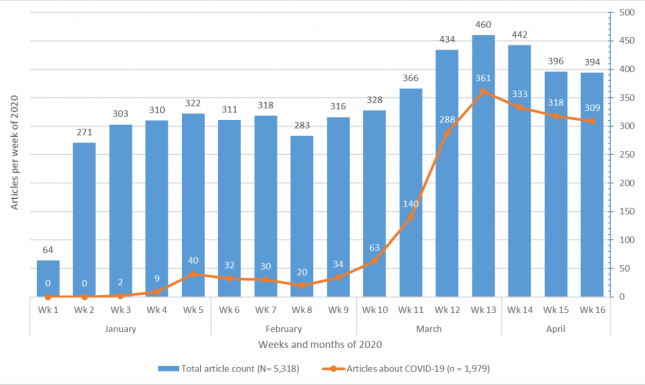

This large volume of articles referring to COVID-19 turns The Conversation into a unique source for studying the broader dissemination and impact of research conducted in the context of the disease. This made us wonder: What are the most prominent topics in the discussion of COVID-19 that have been put forward in The Conversation?
Exploring the words in the full texts of articles referring to COVID-19, we took into account articles in English and focussed on two regional editions: The UK (354 articles), and Africa (108 articles). Based on the terms extracted, we created term maps with the help of VOSviewer. Visualizations made with this software reveal the connectedness of terms: The distance of two terms in the visualization represents how often they co-occur in articles. On the other hand, the overall presence of a term is represented by the size of its label. Furthermore, VOSviewer groups terms into thematic clusters.
What did we find? Figure 2 shows a visualization of all terms from the UK subset.
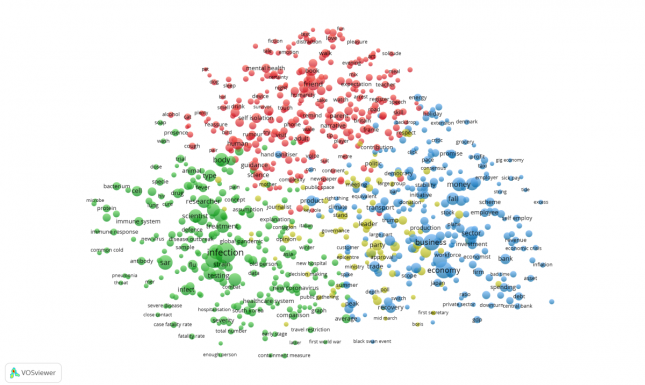

Four clusters become apparent in the UK edition. Starting with the green cluster on the left, we find terms related to the virologic and epidemiologic aspects of COVID-19 (see figure 3), including terms like “infection”, “patient”, or “immunity”.
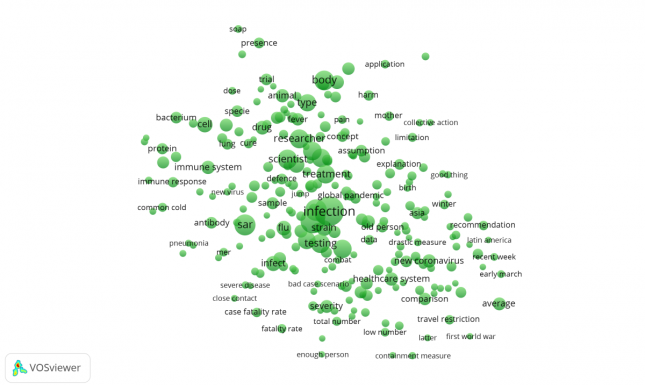

The blue cluster on the right is concerned with the economic impact of COVID-19 and the national lock-down – see figure 4; it includes terms such as “business”, “money”, or “economy”.
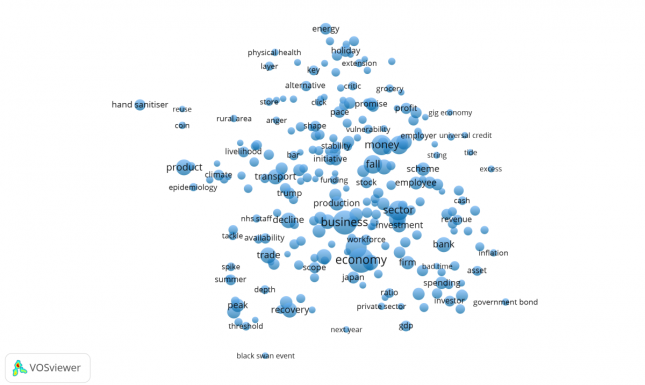

Spread in between the blue and the green cluster is the yellow one – which may be related to the political discourse around COVID-19 (see figure 5), with terms such as “governance”, “leader”, and “party”.
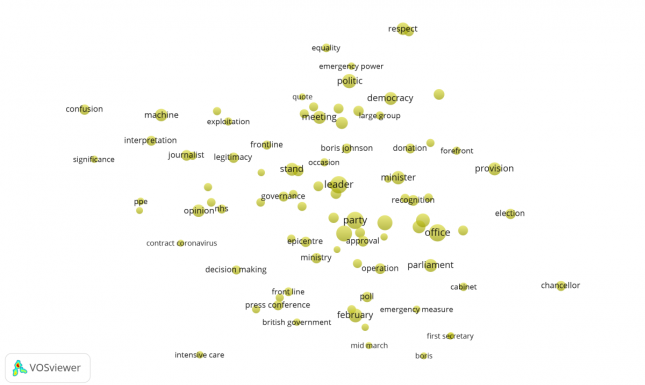

This placement of the ‘political cluster' between the other clusters seems quite plausible, given the role of politics as a broker between the medical and clinical necessities required due to the disease, and the ensuing socio-economic implications. Finally, the red cluster at the top of the map contains terms that are related to the more social aspects of COVID-19 and the effects of the lock-down on people (see figure 6), with terms such as “friend”, “interaction”, or “mental health”.
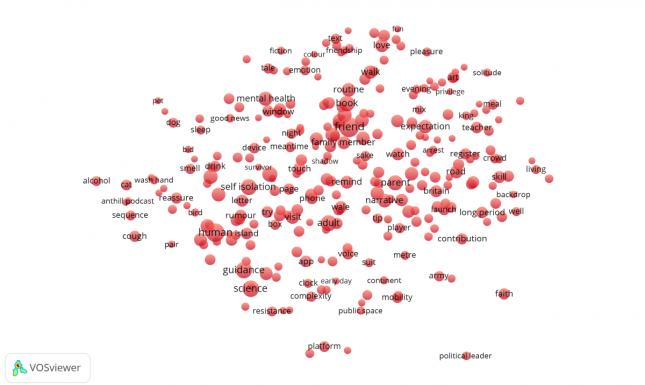

Interestingly, the picture evident with the UK changes when conducting the same analysis for the African edition of The Conversation (see figure 7).
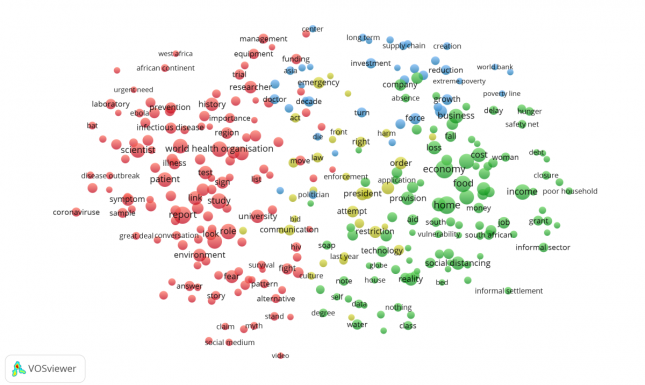

Here, we also find four clusters, but the cluster focusing more on the disease itself (in red, on the left, figure 8) and the economic cluster (in green, on the right, figure 9) are more dominant than in the case of the UK.
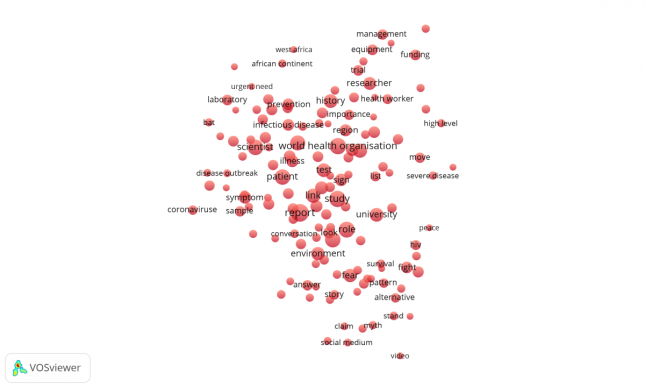

Furthermore, the more social aspects of the measures taken against COVID-19 are more strongly interwoven into the economic terms (see figure 9) than is the case with the UK, where the social aspects formed into a cluster of its own.
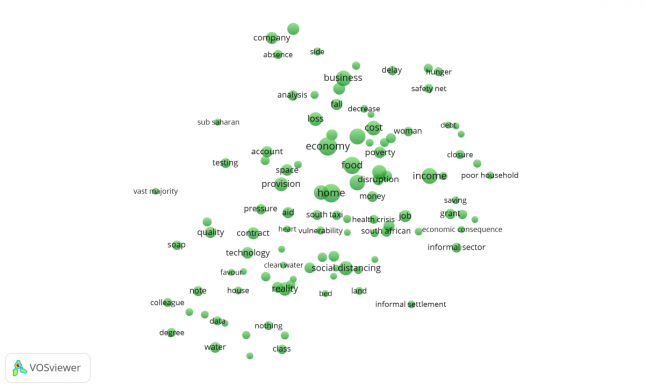

One should keep in mind, though, that the African edition has issued fewer articles than the UK edition in the time period observed. Thus, the results described may (also) be artifacts of the activity of the different editions.
Finally, we can also inspect when which terms were most prominent over time (see figure 10). While terms directly related to COVID-19 and its outbreak dominated earlier this year, we observe that the focus has later on shifted to the socio-economic implications.
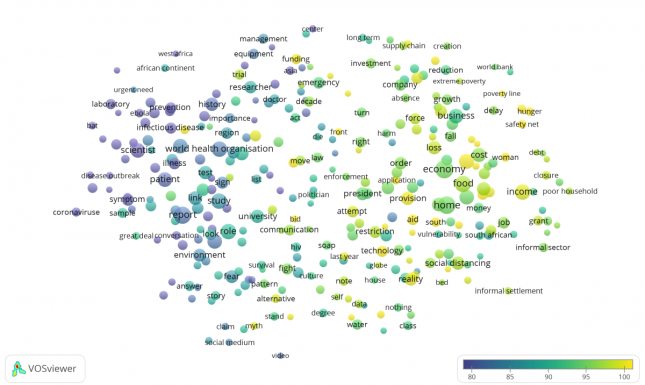

What can we learn from all this? The different clusters that became apparent in the analysis show that COVID-19 brings about challenges in different contexts – and it shows: these challenges found their way into a science-oriented discussion, at least in The Conversation. Furthermore, the differences in the coverage of the UK and the African edition call attention to account for the different needs raised by different communities in the wake of the pandemic. We plan to further investigate this, possibly spotting some of the hot/cold topics that may become apparent when taking different geographical perspectives. Finally, the dimension of time may further provide insights into the development of the discussion.
We believe this inquiry holds value in two ways: First, we learn about the medium The Conversation itself. Which topics are covered, how does it react to, adopt and contribute to the ongoing scientific discussion around COVID-19? Such an understanding could constitute a powerful use case for contemporary science communication. Then, novel perspectives on science (as, e.g., disseminated around COVID-19) may be expected as well: As far as The Conversation articles include references to scientific publications, we may learn more about these studies, given how they are contextualized here. But that is up to another blog post…




0 Comments
Add a comment